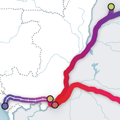Abstract
Thirty years after the discovery of HIV-1, the early transmission, dissemination, and establishment of the virus in human populations remain unclear. Using statistical approaches applied to HIV-1 sequence data from central Africa, we show that from the 1920s Kinshasa (in what is now the Democratic Republic of Congo) was the focus of early transmission and the source of pre-1960 pandemic viruses elsewhere. Location and dating estimates were validated using the earliest HIV-1 archival sample, also from Kinshasa. The epidemic histories of HIV-1 group M and nonpandemic group O were similar until ~1960, after which group M underwent an epidemiological transition and outpaced regional population growth. Our results reconstruct the early dynamics of HIV-1 and emphasize the role of social changes and transport networks in the establishment of this virus in human populations.
